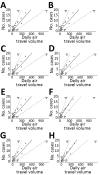Identifying Locations with Possible Undetected Imported Severe Acute Respiratory Syndrome Coronavirus 2 Cases by Using Importation Predictions
- PMID: 32207679
- PMCID: PMC7323530
- DOI: 10.3201/eid2607.200250
Identifying Locations with Possible Undetected Imported Severe Acute Respiratory Syndrome Coronavirus 2 Cases by Using Importation Predictions
Abstract
Cases of severe acute respiratory syndrome coronavirus 2 (SARS-CoV-2) infection exported from mainland China could lead to self-sustained outbreaks in other countries. By February 2020, several countries were reporting imported SARS-CoV-2 cases. To contain the virus, early detection of imported SARS-CoV-2 cases is critical. We used air travel volume estimates from Wuhan, China, to international destinations and a generalized linear regression model to identify locations that could have undetected imported cases. Our model can be adjusted to account for exportation of cases from other locations as the virus spreads and more information on importations and transmission becomes available. Early detection and appropriate control measures can reduce the risk for transmission in all locations.
Keywords: 2019 novel coronavirus disease; COVID-19; SARS-CoV-2; coronavirus; outbreak; pneumonia; respiratory infections; severe acute respiratory syndrome coronavirus 2; travelers health; viruses; zoonoses.
Figures



Update of
-
Using predicted imports of 2019-nCoV cases to determine locations that may not be identifying all imported cases.medRxiv [Preprint]. 2020 Feb 11:2020.02.04.20020495. doi: 10.1101/2020.02.04.20020495. medRxiv. 2020. Update in: Emerg Infect Dis. 2020 Jul;26(7):1465-1469. doi: 10.3201/eid2607.200250. PMID: 32511458 Free PMC article. Updated. Preprint.
References
-
- World Health Organization. Coronavirus disease 2019. (COVID-19) situation report—15, 4 Feb 2020 [cited 2020 Feb 14]. https://www.who.int/docs/default-source/coronaviruse/situation-reports/2...
-
- Nuclear Threat Initiative and Johns Hopkins Center for Health Security. Global health security index [cited 2020 Feb 14]. https://www.ghsindex.org
-
- US Environmental Protection Agency. Data quality assessment: statistical methods for practitioners EPA QA/G9-S [cited 2020 Feb 14]. Washington: The Agency; 2006. https://www.epa.gov/sites/production/files/2015-08/documents/g9s-final.pdf
Publication types
MeSH terms
Grants and funding
LinkOut - more resources
Full Text Sources
Miscellaneous

